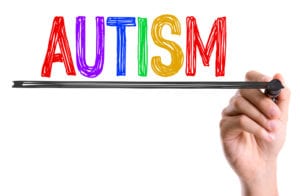Written by Joyce Smith, BS. This study suggests that impaired microbial detoxification pathways may play a role in the development of autism in children.
 Autism is a worldwide, 1 complex, neurological disorder 1 of unknown etiology, 2 affecting many physiological processes in genetically susceptible individuals 3. Digestive enzyme insufficiencies 4 and gut dysbiosis, most notably Bifidobacterium longum deficiency and Clostridium spp. and Candida albicans overgrowth, 5,6 are common. Impaired intestinal microbial detoxification in ASD children allows environmental and internal toxins to enter the blood circulation and injure mitochondrial tissue.
Autism is a worldwide, 1 complex, neurological disorder 1 of unknown etiology, 2 affecting many physiological processes in genetically susceptible individuals 3. Digestive enzyme insufficiencies 4 and gut dysbiosis, most notably Bifidobacterium longum deficiency and Clostridium spp. and Candida albicans overgrowth, 5,6 are common. Impaired intestinal microbial detoxification in ASD children allows environmental and internal toxins to enter the blood circulation and injure mitochondrial tissue.
The following research reveals a mechanism by which altered gut bacterial population in ASD children can lead to abnormal microbial detoxification and mitochondrial dysfunction. By utilizing the enhanced power of the quasi-paired cohort strategy, researchers 7 identified a previously unidentified ASD-associated deficiency in microbial detoxification, which they found was strongly associated with both the extent of mitochondrial dysfunction and the severity of the ASD clinical manifestations. Evidence of this process sheds light on the vulnerability of our ASD children to environmental toxic exposure and lends credence to the potential role of impaired microbial detoxification in ASD pathogenesis.
The study consisted of 79 participants, 39 ASD children and 40 age- and gender-matched neurotypical (non ASD) controls (3 to 8 years of age; 82% males). Metagenome sequencing and analysis of stool samples identified a microbiome that was similar between both ASD and non-ASD groups. Among the 209 sequenced species, 18 showed significant differences between the two groups with Veillonella parvula and Lactobacillus rhamnosus enriched in ASD and B. longum and Prevotella copri enriched in controls. The next step was the generation of a quasi-paired cohort. This involved pairing specific ASD samples with control samples of similar metabolic backgrounds to create a paired cohort, thus controlling for individual diversity and increased statistical power. This allowed the researchers to identify not only minor differences in bacterial populations, but also key downstream metabolic differences between ASD and neurotypical subjects.
Five specific metabolic pathway deficiencies were detected in the ASD group. These deficiencies were linked to detoxification processes that were triggered by certain enzymes produced by gut bacteria. Eight enzymes involved in degrading toxins were significantly deficient in the ASD group. These enzymes play roles in the degradation of a wide range of toxicants that are commonly used in insecticides and food additives. They include chloroalkane/ chloroalkene, aminobenzoate, benzamide, styrene, naphthalene, xylene, and benzoate. Other identified ASD-associated pathways were consistent with previous knowledge about ASD, and included many that are involved in the biosynthesis of pyrimidine, purine, and tetrahydrofolate in ASD children. Of the 39 ASD-associated pathways, folate deficiency and yeast overgrowth were strong contributors to metabolic breakdown.
This study suggests that impaired intestinal microbial detoxification allows environmental and internal toxins to enter the blood circulation and injure mitochondrial tissue. Evidence of this process sheds light on the vulnerability of the ASD child to environmental toxic exposure and lends credence to the potential role of impaired microbial detoxification in ASD pathogenesis. Hopefully the protective role of intestinal microbes will be successfully harnessed as potential future therapeutic strategies to correct the impaired microbial detoxification presently seen in patients with ASD.
Source: Zhang, Mengxiang, Yanan Chu, Qingren Meng, Rui Ding, Xing Shi, Zuqun Wang, Yi He et al. “A quasi-paired cohort strategy reveals the impaired detoxifying function of microbes in the gut of autistic children.” bioRxiv (2020).
Copyright © 2020 The Authors. Distributed under a Creative Commons Attribution Non Commercial License 4.0 (CC BY-NC).
Click here to read the full text study.
Posted January 18, 2021.
Joyce Smith, BS, is a degreed laboratory technologist. She received her bachelor of arts with a major in Chemistry and a minor in Biology from the University of Saskatchewan and her internship through the University of Saskatchewan College of Medicine and the Royal University Hospital in Saskatoon, Saskatchewan. She currently resides in Bloomingdale, IL.
References:
- Posar A, Resca F, Visconti P. Autism according to diagnostic and statistical manual of mental disorders 5(th) edition: The need for further improvements. Journal of pediatric neurosciences. 2015;10(2):146-148.
- Baio J, Wiggins L, Christensen DL, et al. Prevalence of Autism Spectrum Disorder Among Children Aged 8 Years – Autism and Developmental Disabilities Monitoring Network, 11 Sites, United States, 2014. Morbidity and mortality weekly report Surveillance summaries (Washington, DC : 2002). 2018;67(6):1-23.
- Lyall K, Croen L, Daniels J, et al. The Changing Epidemiology of Autism Spectrum Disorders. Annual review of public health. 2017;38:81-102.
- Kushak RI, Lauwers GY, Winter HS, Buie TM. Intestinal disaccharidase activity in patients with autism: effect of age, gender, and intestinal inflammation. Autism : the international journal of research and practice. 2011;15(3):285-294.
- Zhang M, Ma W, Zhang J, He Y, Wang J. Analysis of gut microbiota profiles and microbe-disease associations in children with autism spectrum disorders in China. Sci Rep. 2018;8(1):13981.
- Liu F, Li J, Wu F, Zheng H, Peng Q, Zhou H. Altered composition and function of intestinal microbiota in autism spectrum disorders: a systematic review. Transl Psychiatry. 2019;9(1):43.
- Zhang M, Chu Y, Meng Q, et al. A quasi-paired cohort strategy reveals the impaired detoxifying function of microbes in the gut of autistic children. Sci Adv. 2020;6(43).
